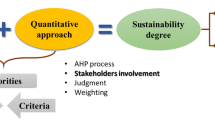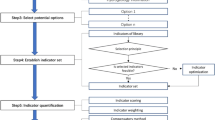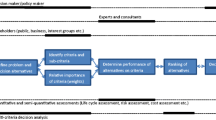Abstract
Government of Canada has identified over 22,000 contaminated sites across Canada. Custodians are responsible to manage environmental risks of their sites to human health and the environment (Treasury Board of Canada Secretariat in Federal Contaminated Sites Inventory, 2015) from identifying the contaminants to choosing an optimal remediation technology. Remediation technologies—apart from their initial goal to minimize risk—can have negative impacts on human health; hence, custodians need a tool that helps them manage human health risks of available remediation technologies. Although existing tools consider various criteria (environmental and socio-economic), a tool that specifically evaluates human health risks of remediation technologies may be missing; therefore this study proposes and designs human health assessment for remediation technologies (HEART) and presents a practical example with site-data. HEART estimates human health risks (cancer and non-cancer) associated with remediation techniques and combines them into a single score to help address exposure and human health risks and fulfill custodian need to select and evaluate remedial technologies.









Similar content being viewed by others
Notes
The term “standard” generally refers to contamination levels that are enforceable under a regulatory framework. In this case, the term property specific standard was used in the RAP which provided the actual site data. In typical terminology for contaminated sites, this would usually be comparable to a site specific guideline. The terminology from the RAP is preserved here for consistency.
While the worker may visit the site frequently, the actual contact with contaminated soil is considered to be infrequent.
The DST is designed to estimate the health risks based on information provided by the user. The user can specify a less conservative concentration based on the site data.
Including the ingestion and inhalation rate, absorption factor, contact duration, skin surface, body weight, and exposure frequency available in remediation check list tool.
References
Anavberokhai IO (2008) Introducing GIS and multi-criteria analysis in road path planning process in Nigeria. A case study of Lokoja, Kogi State. University of Gavle, Gavle, Sweden
Carlon C, Critto A, Nadal N et al (2003) Desyre–Decision support system for rehabilitation of contaminated sites. In: Proceedings of Consoil 2003 8th International Conference on Contaminated Soil. Karlsruhe (DE): Forschungszentrun Karlsruhe GmbH, Gent, Belgium, pp 2987–2993
Contaminated Sites Management Working Group (2000) A federal approach to contaminated sites. Ottawa. http://www.federalcontaminatedsites.gc.ca/8DF3AC07-5A7D-483F-B263-6DE03104319A/fa-af-eng.pdf
Critto A, Cantarella L, Carlon C et al (2006) Decision support-oriented selection of remediation technologies to rehabilitate contaminated sites. Integr Environ Assess Manag 2:273–285
Dodgson JS, Spackman M, Pearman A, Phillips LD (2009) Multi-criteria analysis: a manual. Appraisal 11:16. doi:10.1002/mcda.399
EUGRIS (2011) Cost Analysis of Remediation Options (CARO) Welcome Consortium. Retrieved from http://www.eugris.info/displayresource.aspx?r=4778
Federal Remediation Technologies Roundtable (FRTR) (2002) Decision Support Tool (DST) Matrix. Retrieved from https://frtr.gov/decisionsupport/
Golder Associates Ltd (2012) Development of Government of Canada’s sustainability decision support tool for site remediation. http://golder.goldset.com/portal/project.aspx?id=12. Accessed 15 Jul 2012
Hains S, Noël-de-Tilly R, Bourque B, Michaud J-R, Yelle S, Côté C (2010) A sustainability decision support tool for site remediation in Canada. In: US and EU Perspectives on Green and Sustainable Remediation. US EPA. http://www.clu-in.org/conf/tio/grconsoil_071210/Abstract-cc.pdf
Hartman DH, Goltz MN (2002) Application of the analytic hierarchy process to select characterization and risk-based decision-making and management methods for hazardous waste sites. Environ Eng Policy 3(1):1–7
Health Canada (2010a) Understanding risk management at federal contaminated sites. http://www.hc-sc.gc.ca/ewh-semt/pubs/contamsite/index-eng.php
Health Canada (2010b) Federal contaminated site risk assessment in Canada, Part V: guidance on complex human health detailed quantitative risk assessment for chemicals (DQRACHEM). Ottawa. http://www.hc-sc.gc.ca/ewh-semt/pubs/contamsite/chem-chim/index-eng.php. ISBN: 978-1-100-17926-1
Health Canada (2011) Guidance document for evaluation of potential exposure pathways associated with contaminated site remediation technologies in risk management or remediation plans [Checklist tool]
Health Canada (2013) Environmental and workplace health—environmental contaminants. http://www.hc-sc.gc.ca/ewh-semt/contaminants/index-eng.php. Accessed 28 Jan 2013
Huang I, Keisler J, Linkov I (2011) Multi-criteria decision analysis in environmental sciences: ten years of applications and trends. Sci Total Environ 409:3578–3594
IVM Institute for Environmental Studies (2004) Risk reduction, Environmental merit and Costs (REC). Retrieved from http://www.ivm.vu.nl/en/projects/Archive/REC/index.aspx
Linkov I, Ramadan AB (2004) Comparative risk assessment and environmental decision making. NATO Science Series. Series IV, Earth and Environmental Sciences, vol 38. Springer, Dordrecht. ISBN:978-1-4020-2243-2
Linkov I, Varghese A, Jamil S et al (2004) Multi-criteria decision analysis: a framework for structuring remedial decisions at contaminated sites. Comp Risk Assess Environ Decis Anal 38:15–54
Linkov I, Welle P, Loney D et al (2011) Use of multicriteria decision analysis to support weight of evidence evaluation. Risk Anal 31:1211–1225. doi:10.1111/j.1539-6924.2011.01585.x
Malczewski J (1999) GIS and multicriteria decision analysis. Wiley, New York
National Research Council of Canada’s (NRC) Biotechnology Research Institute and the Montreal Centre of excellence in Brownfields Rehabilitation (2009) Guidance and orientation for the selection of technologies (GOST) remediation tool. http://gost.irb-bri.cnrc-nrc.gc.ca/home.aspx
Onwubuya K, Cundy A, Puschenreiter M, Kumpiene J, Bone B, Greaves J, Teasdale P, Mench M, Tlustos P, Mikhalovsky S, Waite S, Friesl-Hanl W, Marschner B, Müller I (2009) Developing decision support tools for the selection of “gentle” remediation approaches. Sci Total Environ 407:6132–6142
Prato T (2003) Multiple-attribute evaluation of ecosystem management for the Missouri River system. Ecol Econ 45:297–309. doi:10.1016/S0921-8009(03)00077-6
Stockton T, Houghteling W, Black K, Argus R, Avila E, Vega AM, Mcclellan KA (2011) Sustainable management approaches and revitalization tools-electronic (SMARTe). US Environmental Protection Agency, Washington, DC. EPA/600/C-10/007
Sullivan T, Yatsalo B, Grebekov A, Linkov I (2009) Decision evaluation for complex risk network systems (DECERNS) software tool. In: Marcomini A, Suter G II, Critto A (eds) Decision support systems for risk-based management of contaminated sites. Springer, Berlin, pp 247–274
Treasury Board of Canada Secretariat (2011) Reason for federal involvement. http://www.tbs-sct.gc.ca/fcsi-rscf/rfi-rpf-eng.aspx?clear=1
Treasury Board of Canada Secretariat (2015) Federal contaminated sites inventory. http://www.tbs-sct.gc.ca/fcsi-rscf/home-accueil-eng.aspx. Accessed 1 June 2015
UK Environmental Agency (2004) Model procedures for the management of land contamination. Contamination land report (CLR 11). Retrieved from https://www.gov.uk/government/uploads/system/uploads/attachment_data/file/297401/scho0804bibr-e-e.pdf
US EPA (2008) Green remediation: incorporating sustainable environmental practices into remediation of contaminated sites. EPA:542-R-08-002
US EPA (2011) Environmental technology verification program, materials management and remediation center. Retrieved from http://archive.epa.gov/nrmrl/archive-etv/web/html/center-mmr.html
Vranes S, Gonzalez-Valencia E, Lodolo A, Miertus S (2000) Decision support tools: applications in remediation technology evaluation & selection. NATO/CCMS Pilot Study—Evaluation of Demonstrated and Emerging Technologies for the Treatment of Contaminated Land and Groundwater, Special Session—Decision Support Tools. Wiesbaden, pp 42–57
Zargar A, Dyck R, Islam S et al (2012) Data fusion methods for human health risk assessment: review and application. Hum Ecol Risk Assess 20(3):807–838. doi:10.1080/10807039.2012.746145
Acknowledgments
This work was prepared as a part of research contract with Health Canada Prairies region under the supervision of Contaminated Sites (CS) of the Environmental Health Program (EHP) of the Regions and Programs Branch (RAPB). The authors thank and acknowledge Health Canada for their leadership role and data provision. The views and opinions, if any, expressed in this paper and the report does not necessarily reflect the opinion of Health Canada nor is it Health Canada guidance.
Author information
Authors and Affiliations
Corresponding author
Rights and permissions
About this article
Cite this article
Soltani, A., Dyck, R., Hossaini, N. et al. Human health assessment for remediation technologies (HEART): a multi-criteria decision analysis tool. Int J Syst Assur Eng Manag 7, 183–200 (2016). https://doi.org/10.1007/s13198-016-0416-4
Received:
Revised:
Published:
Issue Date:
DOI: https://doi.org/10.1007/s13198-016-0416-4




